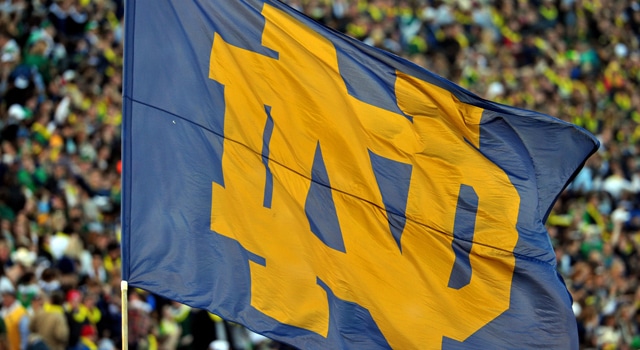
If there is anything that causes college football fans, and in certain cases, coaches, to lose any semblance of rationality, it’s recruiting. College prospects can begin their recruitment process the moment they set foot in high school and are free to provide verbal, non-binding commitments to any program until an official National Letter of Intent is signed on the first week of February their senior year. With ample time between selecting a future home and actually putting ink to paper to make it binding, it should come as no surprise that changes of heart often occur, which can lead to bitter feelings that emanate beyond a program’s fan base.
In 2012, Gunner Kiel, rated as the #1 quarterback in the nation by recruiting site Rivals, offered a verbal commitment to Indiana before flipping to the LSU Tigers. A very short period before signing day, however, Kiel endured yet another change of heart and enrolled at the University of Notre Dame, drawing the ire of LSU’s head coach, Les Miles, who questioned whether Kiel had the “chest” to lead a college program. The late defection left the Tigers with very little time to try and fill the void left by the unexpected departure of an elite quarterback recruit, and Miles was compelled to sign 3-star prospect Jeremy Liggins to cover his bases. Liggins would enroll at a community college and eventually sign with Ole Miss as a junior college transfer, leaving LSU without a quarterback for the Class of 2012.
Such scenarios have become more commonplace within the landscape of college football and are best summarized with a tweet from former High School All-American Shaq Thompson, known for his wild recruitment, when he offered a verbal commitment to the California Golden Bears, decommitted, and re-affirmed his commitment to Cal before ultimately signing with the University of Washington.
“It’s a business…have to do what’s best for me,” he wrote.
A recently proposed solution to the yearly recruiting rollercoaster calls for an early signing period, allowing recruits ready to sign the dotted line an opportunity to do so instead of waiting over one full year, sometimes longer. One immediate benefit of an early signing period would involve combating the rising cost of recruiting. During 2010-2011, numerous universities eclipsed the million dollar threshold in recruiting expenses, not only to sign new talent but to ensure those committed stayed that way. The University of Tennessee ($2.6 million), Alabama ($1.8 million), Florida ($1.06 million), Michigan ($1.06 million) and Notre Dame ($1.008) highlighted some of the heaviest recruiting budgets with Texas ($908k), Florida State ($783k) and Ohio State (618k) not far behind.
An early signing period would also have perks that extend beyond stability and cost effectiveness for college programs. A proposed early signing period would allow recruits to take their five official visits – visits paid for by the hosting university – earlier than the fall, which is the current standard. As the rule currently stands, recruits that visit universities prior to the fall must do so unofficially and at their own expense, a policy that can be cost prohibitive for many recruits and their families. An early signing period would also alleviate the stress of recruits who must endure countless hours of communication from coaches, even after offering their pledge to a given program.
Like any policy, there are still areas of concern. David Shaw, head coach of the Pac-12 champion Stanford Cardinal, opposes an early signing period due to the potential strain it could cause admissions officials, effectively forcing a fast-tracked admissions process. The concern is valid and one prestigious academic institutions should consider, though Shaw’s objection is assuredly a form of self-interest. Stanford is notoriously slow in its admission process, a factor that plagues the Cardinal on the recruiting trail. An early signing period could prove to be problematic for Stanford’s long term success.
Perhaps the biggest concern of all involves enforceability. Should a recruit sign a National Letter of Intent early and subsequently change his mind, would the NCAA honor his signature and force the recruit to transfer to another academic institution and sit out one full season before becoming eligible, or would the NCAA allow the recruit to forego his National Letter of Intent and switch institutions without penalty? Based on recent evidence – such as last year’s ordeal with Eddie Vanderdoes, a recruit who signed a National Letter of Intent with Notre Dame but was allowed to switch to UCLA without penalty before arriving on Notre Dame’s campus – the latter is more likely. And if that is how the new early signing period would function, what purpose would it truly serve? To utilize the Gunner Kiel scenario as context, what would be the difference in outcome between Kiel decommitting from LSU and signing with Notre Dame compared to Kiel signing with LSU and ultimately switching to Notre Dame without penalty?
The best compromise may be to allow an early signing period for recruits who plan to enroll early at their university of choice, foregoing their final semester of high school in order to receive a jump start to their college careers. Such a policy would certainly be music to the ears of the Fighting Irish faithful, as it would allow elite talent such as current Class of 2015 quarterback commitment Blake Barnett, to sign his pledge to Notre Dame early and remove stiff competition from the likes of Alabama and Oregon.
Scott Janssen is a blogger for the Huffington Post and has authored several nationally-featured articles, including an appearance on MSNBC as a sports contributor. He talks football 24 hours a day, much to the chagrin of his fiancée. Scott can be reached at [email protected].





Support it – and will lead nation in most appeals for a release